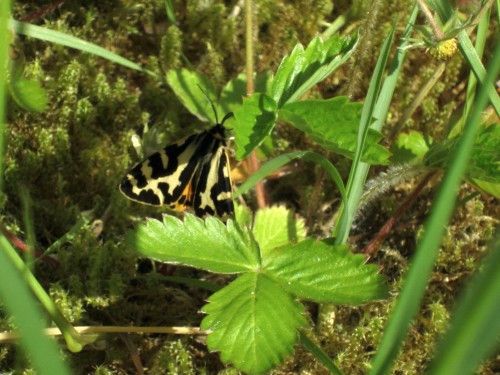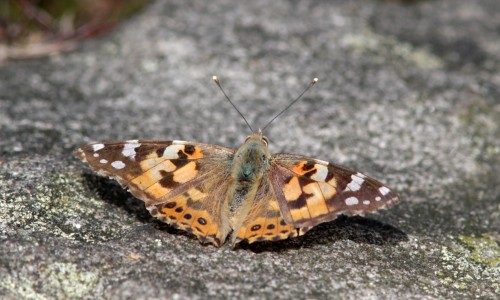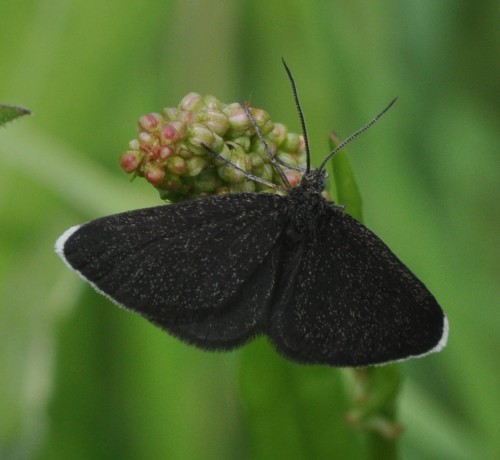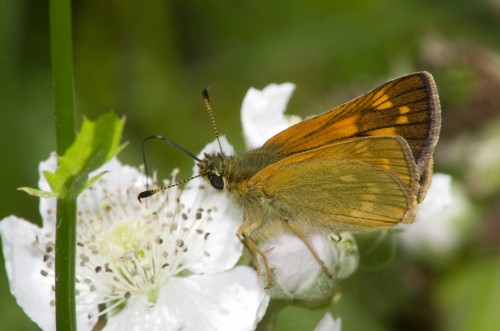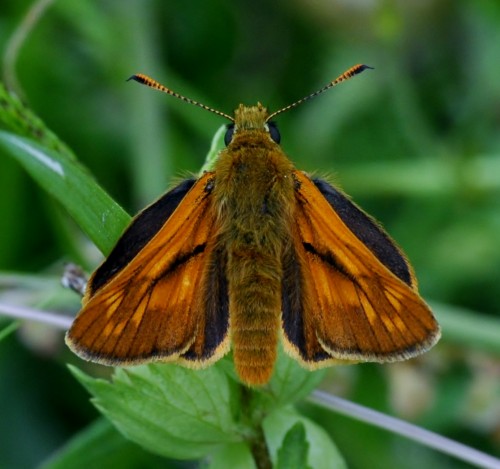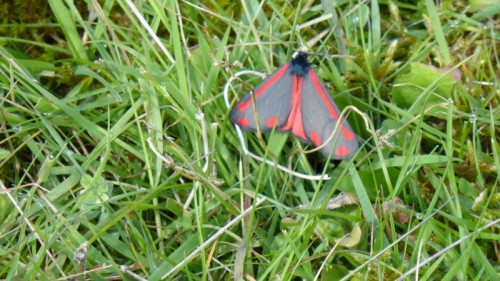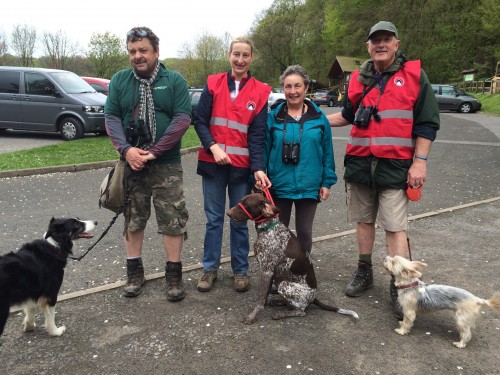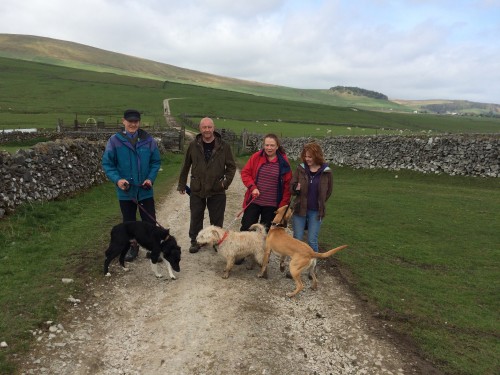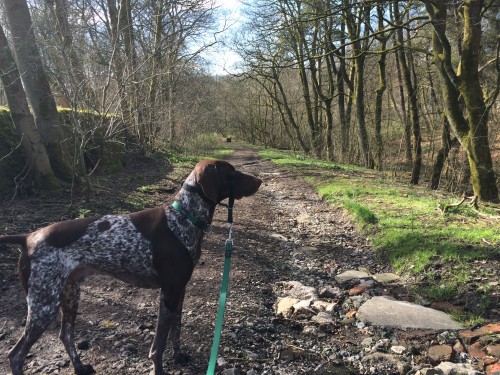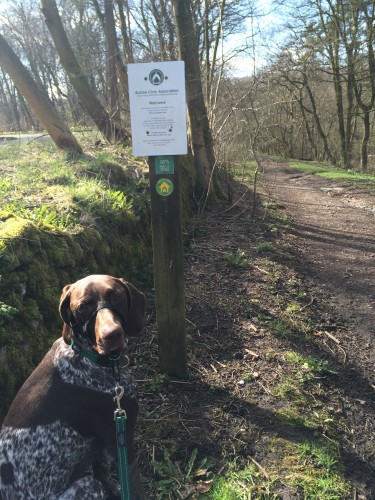Hello Everyone,
Just a quick Update to advise that the recent plume of hot air from the Iberian Peninsular has resulted in a reasonable number of both Painted Lady and Clouded Yellow butterflies reaching the UK and here in Derbyshire we have had 7 sightings of the Painted Lady during the last couple of days! First of all 4 Painted Lady butterflies were seen yesterday (4th June 2015) at Northwood, Darley Dale (Christine Gregory – photo attached) and today Pat and I saw 3 Painted Lady butterflies on the Blackwell Trail near South Normanton, all of which looked fairly worn having been caught up in the strong southerly air flow which spread across the country during the last couple of days.
Hopefully this species will still be around this weekend and I will be pleased to receive details of further sightings within the County.
A couple of additional day flying moths have been recorded during the last week with the Chimney Sweeper moth appearing at some Lowland sites and the Wood Tiger being noted at a few sites in the Peak District (photos attached).
Regards,
Ken Orpe
News and Events
We love to hear about your experience and see your photographs through the seasons. Don't forget to follow us on Facebook and share our pages. We know we've done a great job when you've had a fantastic day out!
Buxton’s Street Trees

View of Buxton from Light wood Resevoir
As part of our campaign to raise awareness about Buxtons Street trees, we held a competition for those that attended the Charity Bazaar on Saturday to guess the number of Street Trees in Buxton.
People's guesses ranged from over 16,000 to 150. The actual number of trees as at 1st June 2015 was 945. No one guessed correctly so the winner will be the person who got closest to the actual total. We will be notifying them separately.
Gadley Wood in early June
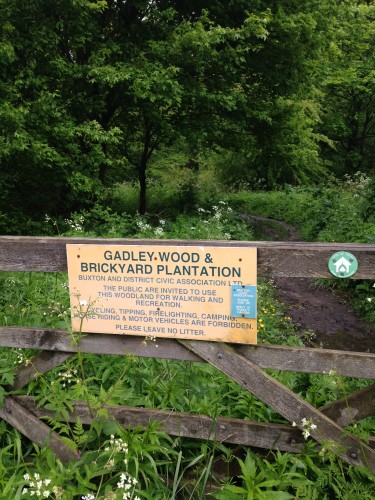
One of the ways into the wood.
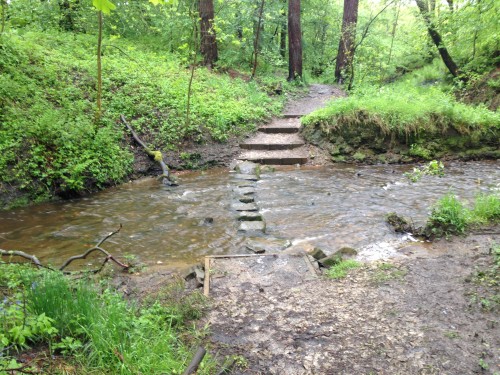
The stepping stones were almost underwater
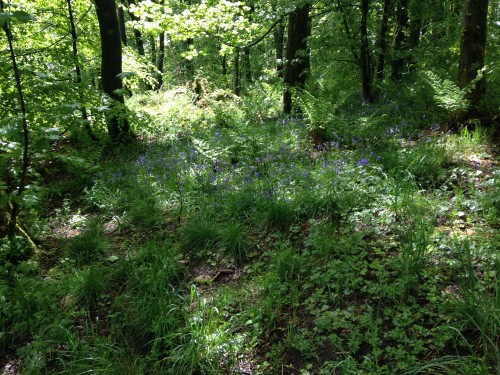
Bluebells were still looking good
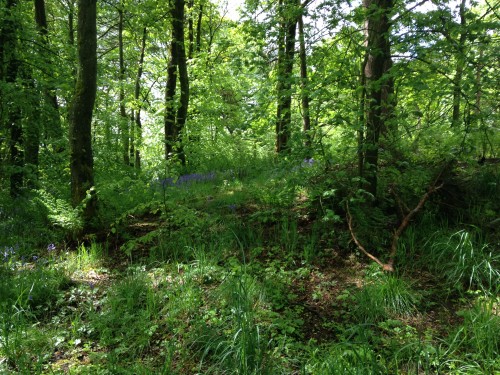
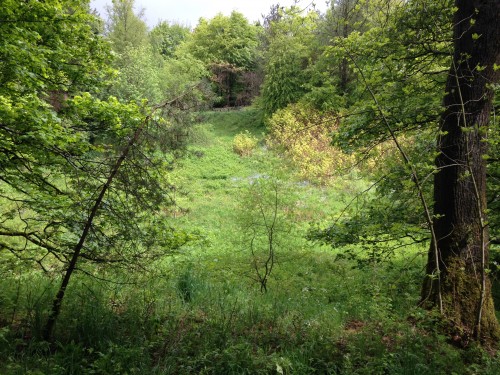
A great open space for birds and invertebrates
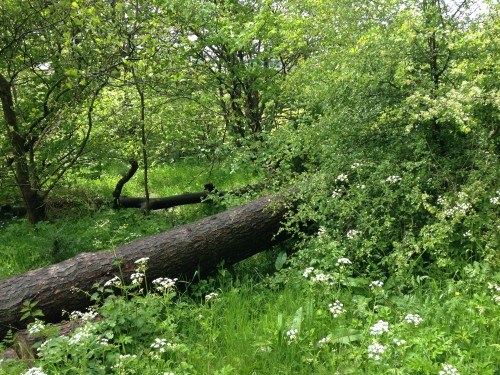
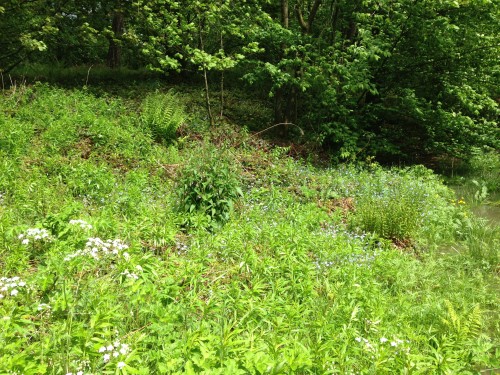
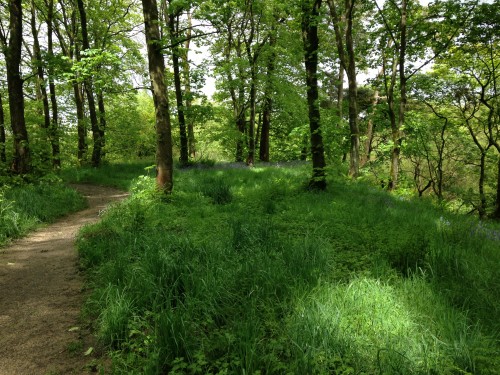
A sequence of photographs taken on an iphone on 2nd June in Gadley wood. It had just stopped raining and the birds especially the great tits were very noisy.
Derbyshire Butterfly Transect Report No 19
Including the First Large Skipper sighting of 2015
Hi Everyone,
In meteorological terms, today is the last day of Spring and May 2015 will go down as a cold and wet month generally (similar to 2013) which explains why the transect results have been particularly poor for what is normally a very productive month for butterflies. Surprisingly, the total number of species seen in the month has been 20 with the addition of the Large Skipper during the last 10 days, the first sighting being on the 21st of May 2015 at Williamthorpe NR (Willy Lane).only 4 days later than the earliest date for this butterfly in 2014. This is the first of the summer skippers to emerge and it is somewhat larger than the other 2 golden skippers – namely the Small Skipper and the Essex Skipper. It also has a chequered pattern on both the upperside and underside of the wings which the other 2 skippers do not have. Also the tips of the antennae, although black underneath, have a hooked end. They are also usually seen perched on foliage, rather than grasses, with bramble being a favourite plant. The other 2 skippers are not expected to be on the wing until mid June (for the Small) and early July (for the Essex) so any golden skipper that is seen in the next couple of weeks is likely to be the Large Skipper.
It is pleasing to note that the Dingy Skipper has managed to survive at most of its known areas in the County with recent sightings coming from 21 sites, mainly brownfield, with a maximum count of 15 being noted on the 22ndth of May 2015 at Ashbourne Airfield (Gary Atkins) and 14 being seen on the 27th of May 2015 at Drakelow NR (Tom Cockburn).
Records of another BAP species, namely the Small Heath are mainly being received from brownfield sites in Lowland Derbyshire but the first sighting from the Peak District and Peak Fringe areas have come from Clough Wood (Peter Faulkner), Northwood Hillside, Darley Dale (Christine Gregory) and at Longstone Edge
(Brian & Jean Hallam).
Even the Holly Blue has managed to take advantage of the odd day that proved to be sunny in May 2015 with a reasonable number of recent sightings coming from a total of 15 sites in Lowland Derbyshire but no recent records from the Peak DIstrict or Peak Fringe areas where presumably the wind chill factor and consequently the temperature had an adverse effect on its appearance there.
However, the Brown Argus migrating has only been reported in very low numbers from a few discrete colonies in Lowland Derbyshire including Drakelow NR (Tom Cockburn), Woodside NR, Shipley (Jim Steele) and Stanton Ironworks (Steve Plant & Ian Hunt).
Common Blues are now being more regularly sighted in the County, although the first record from the Peak District is still awaited, with the Blackwell Trail proving to be a ‘hot spot’ for this species with 73 being seen on the transect there on the 23rd of May 2015 (Helen Naylor) and over 100 noted at the same site by Willy Lane on the 30th of May 2015.This site has benefited by both the current owners, Hall Construction, together with the eventual owners,Derbyshire County Council, working together including taking on board advice from both the Derbyshire Wildlife Trust and Butterfly Conservation to produce a really good habitat for wildlife generally and butterflies in particular, so this site is well worth a visit at sometime during the forthcoming summer (whenever that arrives!)
Only a couple of the ‘blue spotted’ Small Copper were seen recently with sightings at Eyes Meadow, Duffield on the 21st of May 2015 (Mick Ball) and at West Hallam Tip on the 30th of May 2015 (Pat & Ken Orpe) and only a few sightings of the normal version of this species coming from only 6 other sites in the County.
No sightings have been received yet from the Peak District for either the Brown Argus or the Dark Green Fritillary, but the Wall Brown has been noted at Clough Wood (Peter Faulkner), Chee Dale (Robert & Margaret Davies) with a maximum count of 12 at Longstone Edge on the 30th of May 2015 (Brian & Jean Hallam).
Fortunately the poor weather of May 2015 has not curtailed the flight period of the Green Hairstreak with recent sightings up to and including the 30th of May 2015 coming from Northwood Hillside, Darley Dale (Christine Gregory), Coombs Dale (John & Aline Roberts), Hall Dale (Nikki Mahadevan), Padley Gorge (Jim Steele & Karl Proctor) and at Longstone Edge ( Brian & Jean Hallam). Similarly the Orange-tip is still being noted in many parts of the County, albeit in low numbers.
It is pleasing to confirm that a handful of fresh Red Admirals have been seen during the last 10 days including sightings at Aston Brickyards (Pat & Ken Orpe), Hatton Meadows (Alex Charles-Roe) and at Rosliston Forestry Centre (Felicity Towns).
Fortunately the small numbers of butterflies seen on transects have been supplemented by some day flying moths including Burnet Companion, Mother Shipton and Latticed Heath (photos of which were attached to Update no 17) and, in the Peak District, the Speckled Yellow, and recently the Cinnabar moth has emerged (photo attached) to add some colour to the general countryside, especially at those sites that contain the much maligned ragwort plant, upon which this moth depends as it is the main foodplant of its caterpillar, the colour of which are bright yellow with black bands which warn predators that they are very distasteful!
Finally, it will probably not be too long before the first sighting of our most common butterfly is made in the County – namely the Meadow Brown followed by the almost equally abundant Ringlet. both of which were flying by the 9th of June in 2014.
Only your records will be able to confirm whether the above mentioned butterflies have emerged yet within the County – thanks again in anticipation of them!
Regards,
Ken Orpe
WORLD MUSIC at POOLE’S CAVERN

Kora in the Cavern
Saturday 6th June 2015 at 5.15 pm. Kora in the Cavern. Exclusive access to the cavern for a short session by Yankuba and Katus. Wear something warm. Tea and Coffee served afterwards for a donation to the Cavern. No booking required.
Butterfly Transect Report
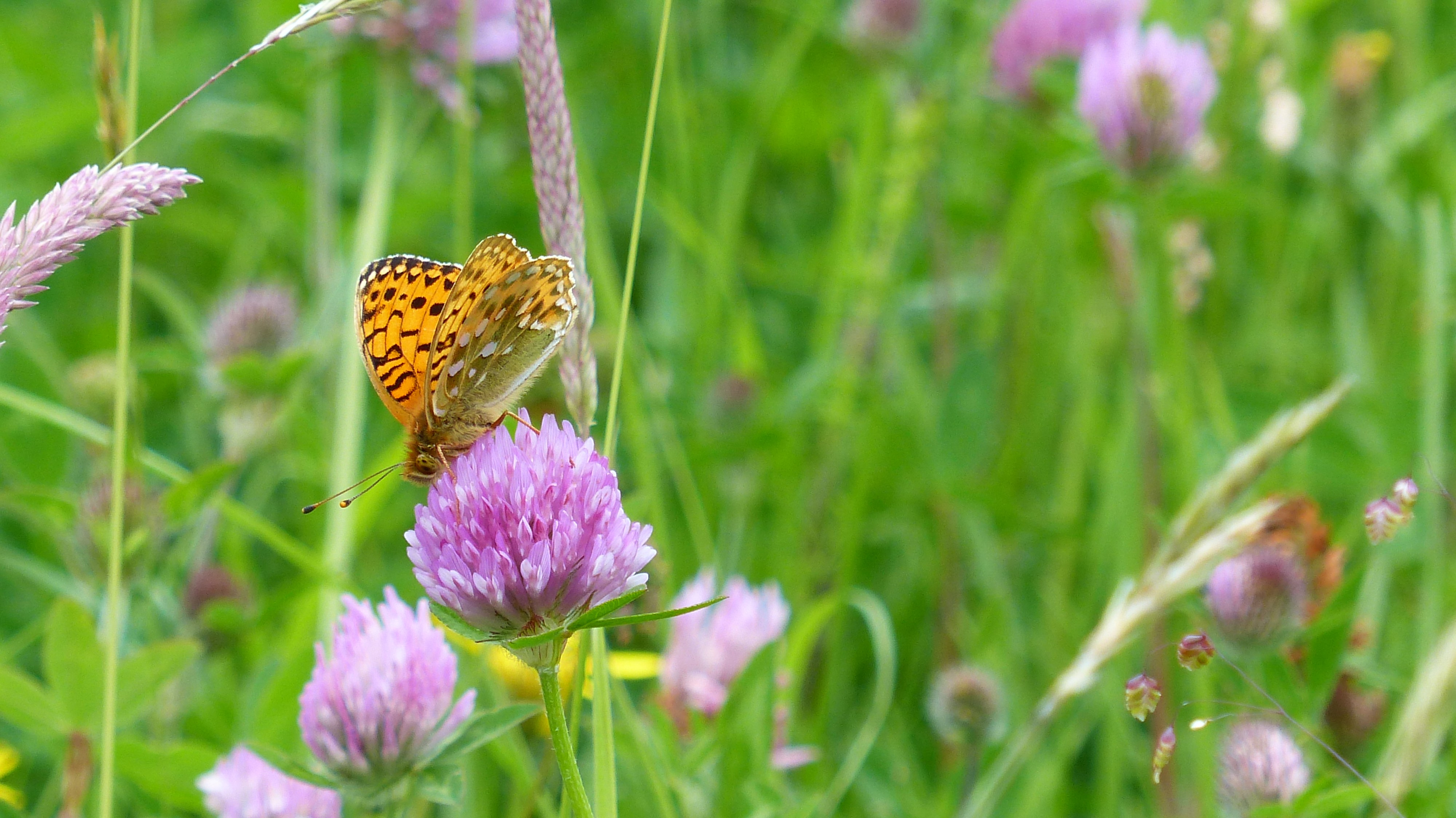
Photograph by Steve Orridge
We have been taking part in the Derbyshire Butterfly Survey, and Steve Orridge has been organising a group of volunteers to carry out a weekly survey in Grin woods. We have attached the latest report for the county wide survey, though at this stage Grin woods do not feature , mainly because the weather has been poor. The report has been compiled from reports across the county by Ken Orpe, the county recorder.
We will be posting these reports on a regular basis and also highlighting the results from Grin woods.
Hi Everyone,
With still no let up in the cold and wet conditions already experienced during May 2015, this has meant that several recorders failed to see even one butterfly on their transects during the last week. Despite this 2 additional butterfly species have managed to defy the odds and emerge recently in the County. First of all Simon Roddis was very surprised to see a fresh Wall Brown in his garden in Darley Dale on the 15th of May 2015 and then on the following day a mint Brown Argus (migrating) was seen by Pat and Ken Orpe at the Stanton Ironworks site, this bringing the May 2015 total to 19 species which is quite a surprise given the very unfavourable weather conditions experienced during the first 3 weeks of this month.
Not surprising but only a few Green Hairstreak sightings have been made during the last week including in Lathkill Dale (Ian White) and at the excellent site in South Derbyshire, namely Stanton Ironworks (Lyn Martin).Similarly only a few Small Copper sightings have been made including Rose End Meadows (Martin Cobham) and Lathkill Dale (Ian White), none of which were noted as being of the ‘blue spotted’ form. Just a handful of sightings of both the Common Blue and Small Heath were made recently including the former species at Stanton Ironworks (Lyn Martin) and the Derbyshire part of Toton Sidings (Brenda Meakin), whilst sightings of the latter species were made at Langley Mill Tip (Colin Penny) and at Stanton Ironworks (Pat & Ken Orpe). Although there have been no further sightings of the Painted Lady in the County recently, it is pleasing to report that Red Admirals were noted at Carsington Water (Brian Romans) and at Buxworth (Damian Hughes) during the last 7 days.
The highlight of the last week has been the number of sightings of the Dingy Skipper including at a new site at Ashbourne Airfield (Trevor Taylor) together with those at known brownfield sites in Lowland Derbyshire including Kilburn Tar Pits (Austin Thomas), Langley Mill Tip/Station (Colin Penny), the Derbyshire part of Toton Sidings (Brenda Meakin & Richard Rogers), West Hallam Tip/Peewit Carr Complex (Pat & Ken Orpe), Stanton Ironworks (Lyn Martin; Pat & Ken Orpe),
Drakelow NR (Tom Cockburn), Williamthorpe NR (Willy Lane), Poulter Country Park (Andy Laking & Shell), Poolsbrook Country Park (Glyn Morris), Barlborough Links (Colin Morris) and the Avenue Washlands, Wingerworth (Sam Ellis). In the Peak District sightings have been made at Cheedale (Steve Orridge) and Rose End Meadows NR (Martin Cobham & James Bradbury)., whilst in the Peak Fringe area, this species was noted at Crich Chase (Ross Pearson) and interestingly in an open area on the woodland walk at Crich Tramway Museum (Ian Hunt).
Finally although not actually to do with Lepidoptera, many recorders enjoy the sight and noise of ‘screaming’ swifts as they swoop around the rooftops of our area having travelled to us from Equatorial Africa. The Derbyshire Wildlife Trust and the Derbyshire Ornithological Society are running a project on Swifts, which is a rapidly declining species. While they have only two and not four wings (!), should you see any flying BELOW roof height or even entering buildings please send full details (including property numbers/street names, post codes) to the survey organiser, Nick Brown nbrown@derbyshirewt.co.uk
Also, recently a definitive book on the Flora of Derbyshire was launched which is the first book on the subject since 1969 and it describes over 1900 plant species that can be found in the County together with over 1100 distribution maps of most of the species. In this connection it is possible to compare food plants of the caterpillars of Lepidoptera with the current distribution maps of particular butterfly species with, for example, Common Rock Rose and the distribution of the Brown Argus in the Peak District. With permission of Nick Moyes, one of the authors, I have attached the distribution map of Common Rock Rose for comparison with the distribution of the said butterfly. It can clearly be noted where the plant has been seen and then it is possible for searches to be made to establish whether the butterfly is also resident in those areas – clearly a challenge if recorders want to contribute to the knowledge of this Peak District speciality butterfly!
If you wish to purchase a copy of this excellent new hardback book, please look for the "Buy The Book" tab here: http://floraofderbyshire.blogspot.co.uk
Regards,
Ken Orpe
Historic Towns Forum May Newsletter
Photos from the Social Dog Walk
Dawn Chorus Grin Woods
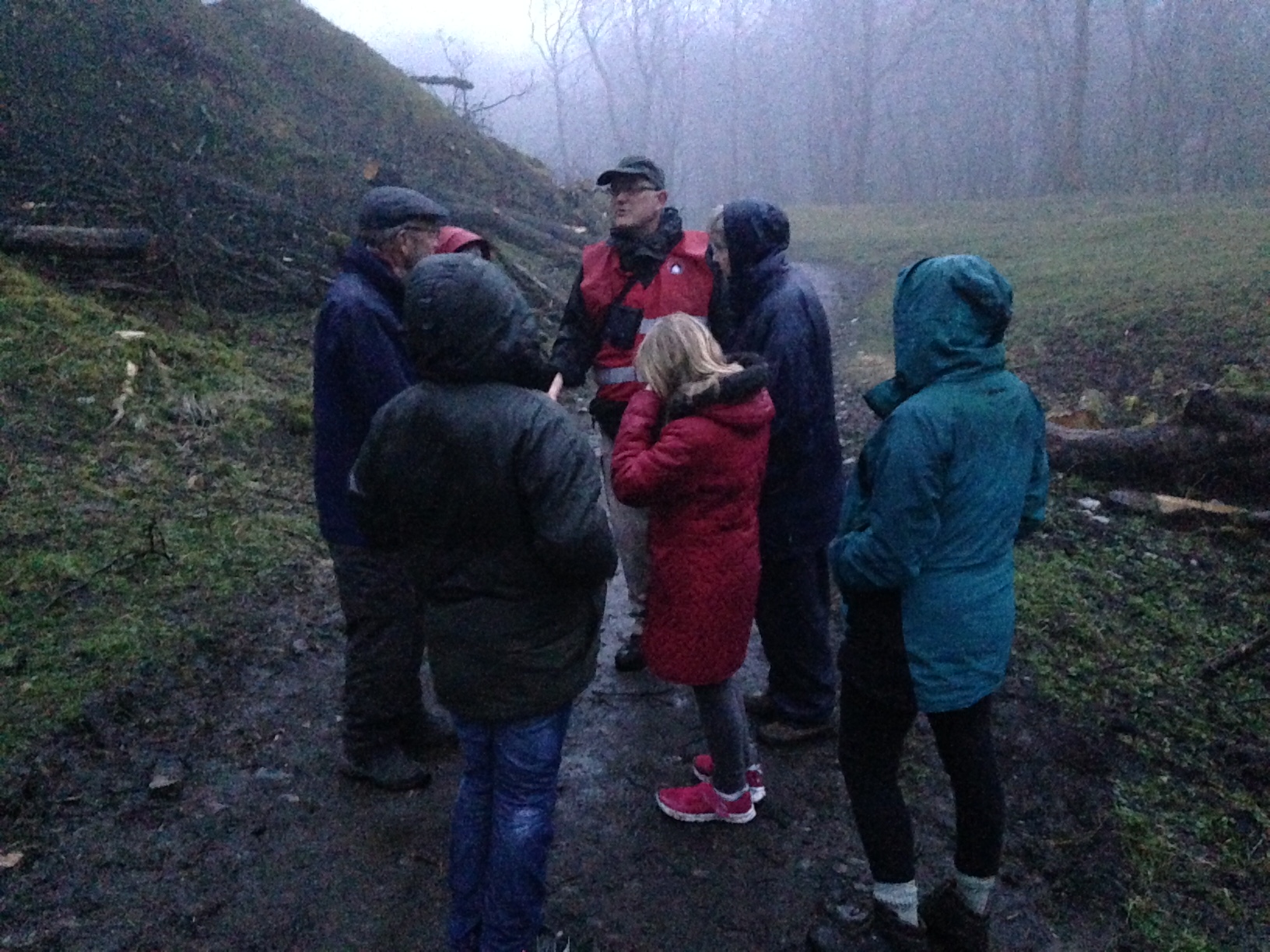
Listening intently in the rain.
Report on BCA members dawn chorus walk
International dawn chorus day dawned, wet, very wet, and with just enough of a wind to make sure that you stayed chilled and cold. So it was just before five am on Sunday morning, that we, six adults and two children, gathered in Poole's Cavern visitor's car park, with rapidly dampening spirits and even damper Cagoules to celebrate international dawn chorus day with an early morning walk in Grin woods. A song thrush was awake though and despite the rain, sang us a welcome song, as we set off into the gloom and dankness of grin wood. Now I am not going to claim that I know the wood like the back of my hand, but over the twenty five years that I have been walking there, I guess I would say that I know it reasonably well. Not as well as the younger members of our party though. They seemed to know all the secret paths, and having the super observational skill of the young, had soon spotted what they thought might be badger claw marks. They might well have been right, but by now any self-respecting badger would have been tucked up in his sett; dry, warm, cosy and settling down for a nice lie in.
We stopped by the tree with the swinging branch and listened. Blackbirds and Robins competed with each other orchestrating a beautiful melody whilst in the background a wren favoured a more atonal call. As we moved on the rain intensified, robins and blackbirds continued to vie for pride of place and Steve claimed he heard a tree creeper.
We stopped again in the clearing that links the glades. A wood pigeon made a brief appearance, a blue tit kept up a steady barrage, and a couple of crows called from the top of the canopy. The light fitfully and reluctantly chased away the shadows and the wood began to resemble its old familiar self. The birds were falling silent. The rain was steady; we beat a hasty retreat back to the car park. It had been an experience.
The number and variety of species that we heard on Sunday was disappointing even allowing for the rain. One of the reasons for creating the woodland ride is to increase the variety of habitats available , that will in the long run improve the bio diversity of the wood and lead to an increase in the range of flora and fauna.
Species that we didn't hear but we know are in the woods are; Nuthatch, Coal and Great Tit, Chiffchaff, Willow Warbler and Pied Flycatcher.
You can listen to a short clip of the some of the species that we heard by clicking on the link below.
